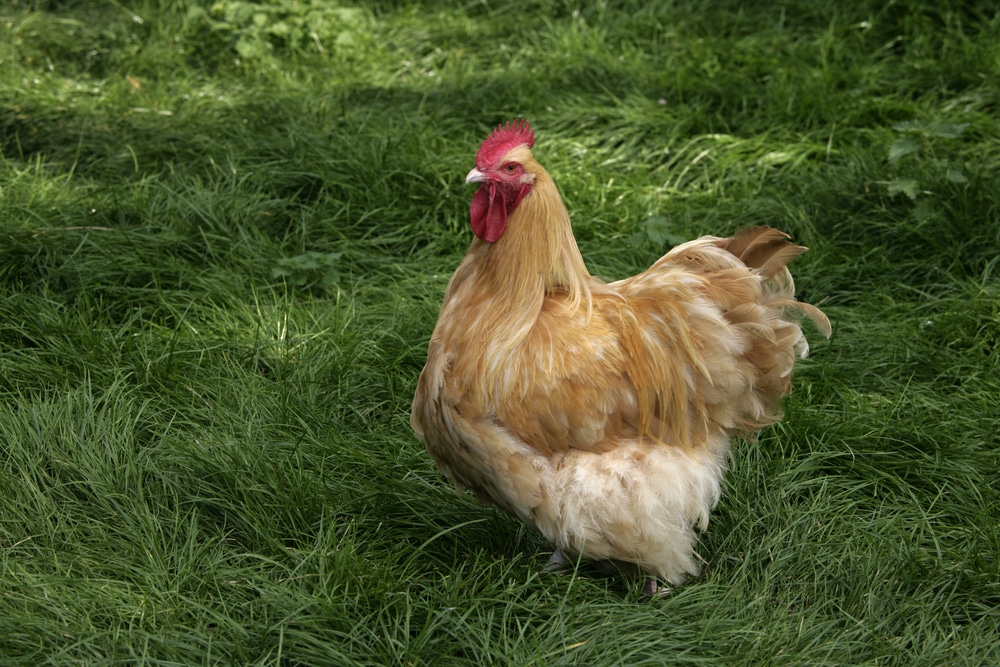There is perhaps no other chicken breed that can spice up your backyard flock quite like the Buff Orpington.
The quintessential backyard chicken breed, the Orpington is a relatively modern breed that was created with the goal of producing a dual-purpose chicken that was not only bigger but also more productive than other breeds.
Today, the Buff Orpington is one of the most popular versions of the Orpington chicken breed available. Offering a ton of benefits to chicken owners, this bird is one you have to see to believe!
[toc]
History of the Breed
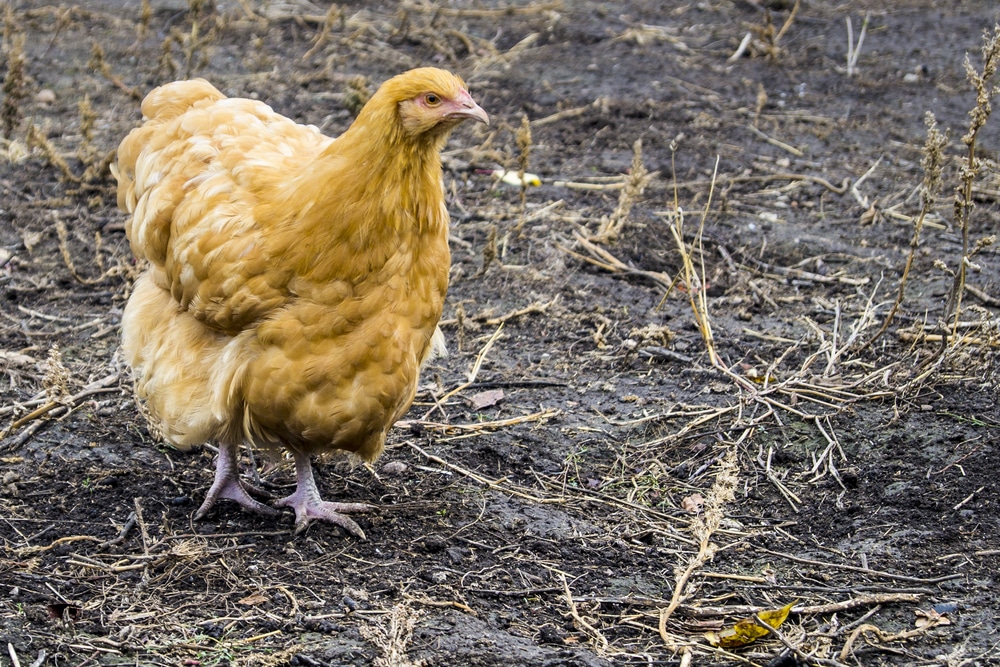
Originally developed as a dual-purpose chicken breed, the Buff Orpington was first raised by William Cook, a coachman from the county of Kent, England. The name of his hometown? Why, none other than Orpington! What a coincidence.
Cook developed an interest in raising chickens later in his life, fascinated by the potential to breed a chicken that could get people interested in raising chickens again. By the late 1880s, raising chickens had become less popular, and Cook sought to “reinvent” the idea of the quintessential backyard chicken.
This innovator began by choosing birds that were not only a decent size for the dinner table, but were also exceptionally good at laying eggs. He selected three major breeds to produce his breeding stock: Langshan, Minorca, and Plymouth Rock chickens.
In 1886, the first Orpington chicken – the Black Orpington – was unveiled. This chicken became almost immediately popular, prized for its balk color that could hide the dirt and ash that were common in English cities at the time.
After the Black Orpitnong became such a success, Cook developed the Buff Orpington (with the White, Splash, and Blue colorations arriving shortly after). This chicken was created with a combination of breeds like Buff Cochins, Dorkings, and Hamburgs. This was quite controversial at the time, as it was up to that point uncommon to use multiple breeds to create color variations within a breed.
This chicken largely became a success in the United Kingdom and beyond, exported to the United States a mere decade later. Because Cook was such an excellent breeder and salesperson, it didn’t take long for him to convince others that this breed was one worth keeping around.
Today, the Buff Orpington is one of the world’s most popular breeds. A heritage chicken, it was even the favorite breed of Queen Elizabeth!
Appearance
Considered endangered until 2016, the Orpington chicken breed is enjoying a major resurgence. It has since been removed from the American Breed Livestock Conservancy list as interest in the buff variation of the breed, in particular, continues to go up. The American Poultry Association added the Orpington colors to its standards over a period of two decades, first recognizing the Buff color before moving on to black, white, and blue.
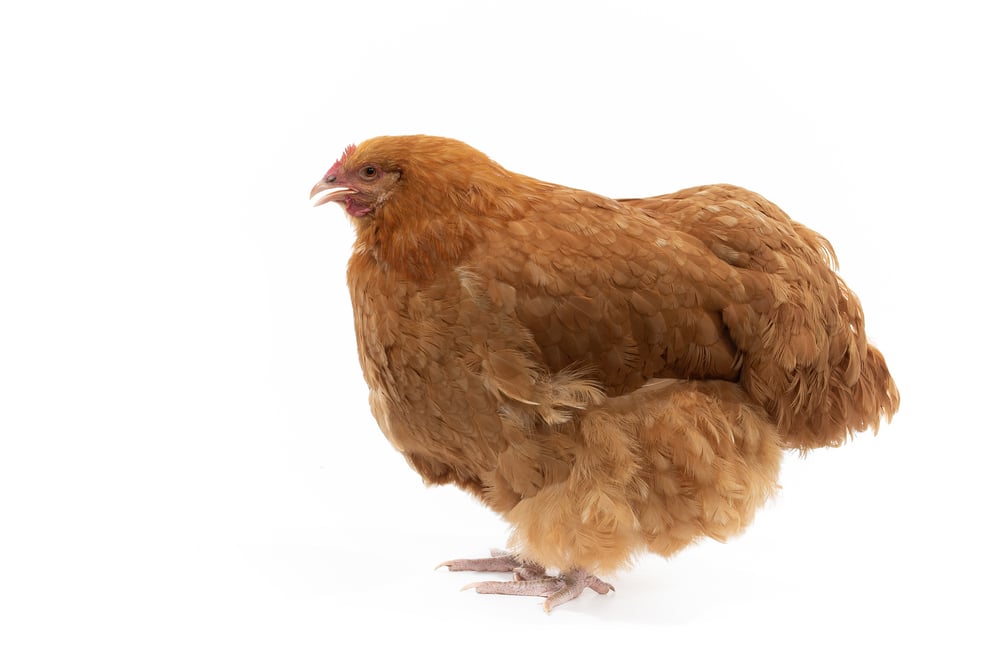
There are a few characteristics that the breed must meet. It should have a broad, heavy body with a stance that is relatively low to the ground. It has feathers that remain fluffed out along with a short, curved back.
The Buff Orpington is known for being well-feathered, with feathers of a pale yellow or golden hue. The chicken has shanks and feet that are pinkish-white in color and clean to the touch. The beak, too, is pinkish white.
Although there is a less common rose comb variety of the Buff Orpington, the single comb version is without a doubt the most popular. The eyes of this chicken are a red shade, while combs, earlobes, and wattles are also red.
You can generally find the Buff Orpington in two sizes – regular(Large) and bantam.
Large Buff Orpingtons will weigh in at around ten pounds for the male and eight for the hen. Bantams will be much smaller, tipping the scales at just 38 ounces! All other aspects of the bantam Buff Orpington, however, match that of the Large.
Behavioral Characteristics
A friendly and docile chicken breed, the Buff Orpington is known as the friendliest and calmest of all the Orpington varieties. A calm, stately chicken, it glides around the barnyard in search for food. It enjoys being held and likes the attention of humans.
With fantastic feathering, this chicken is incredibly cold-hardy. It is important to note that a wet Buff Orpington is something to watch out for – when these birds become chilled, they can become hypothermic and die quickly.
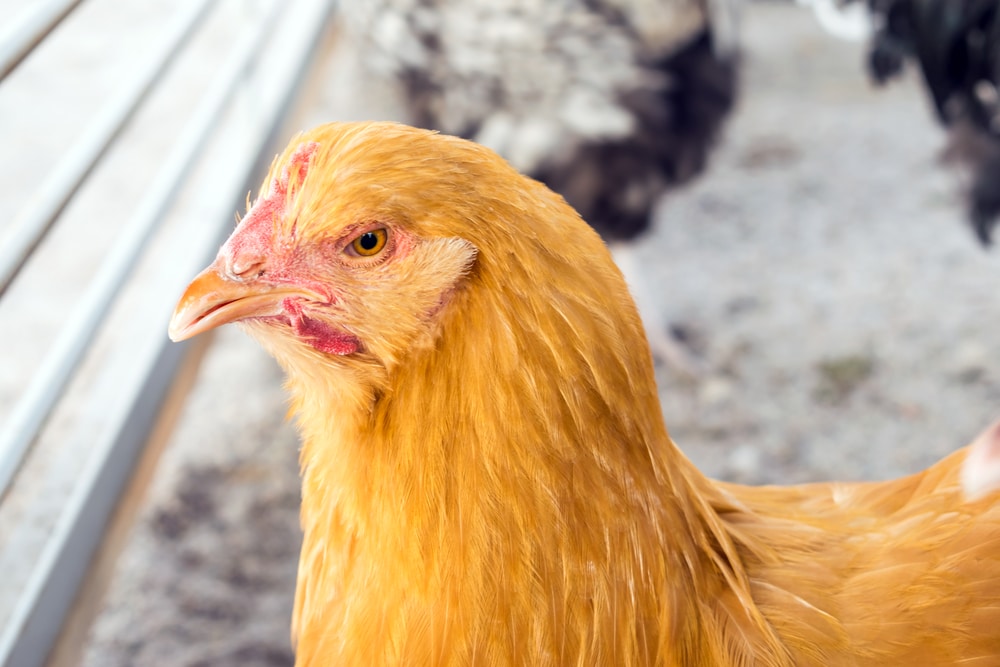
Buff Orpingtons are excellent mothers, doing a great job of brooding their own eggs. They will also occasionally hatch eggs from other mothers that you place beneath them. The roosters of this breed are unique, as they are known to be highly protective – and in some cases, they will sit on the nests themselves to give the hens a break!
One of the best chicken breeds for families, the Buff Orpington is tolerant of all kinds of energy and activity in its pen. Although these chickens won’t hesitate to defend themselves if needed, they are incredibly laidback and are an excellent choice for 4H clubs and exhibition.
Not easily upset by frequently handling, the Buff Oprington also tolerate confinement with ease. Although these chickens will free range if given the chance, they also have a tendency to rely heavily on their feeders.
This chicken is absolutely lovely to behold. It moves in a gentle gliding motion, offering a sophisticated and classy air to your entire chicken run. It will even let you know when it’s ready for some loving, emitting soft little cries to encourage you to pick it up!
Ideal Environment for a Buff Orpington Chicken
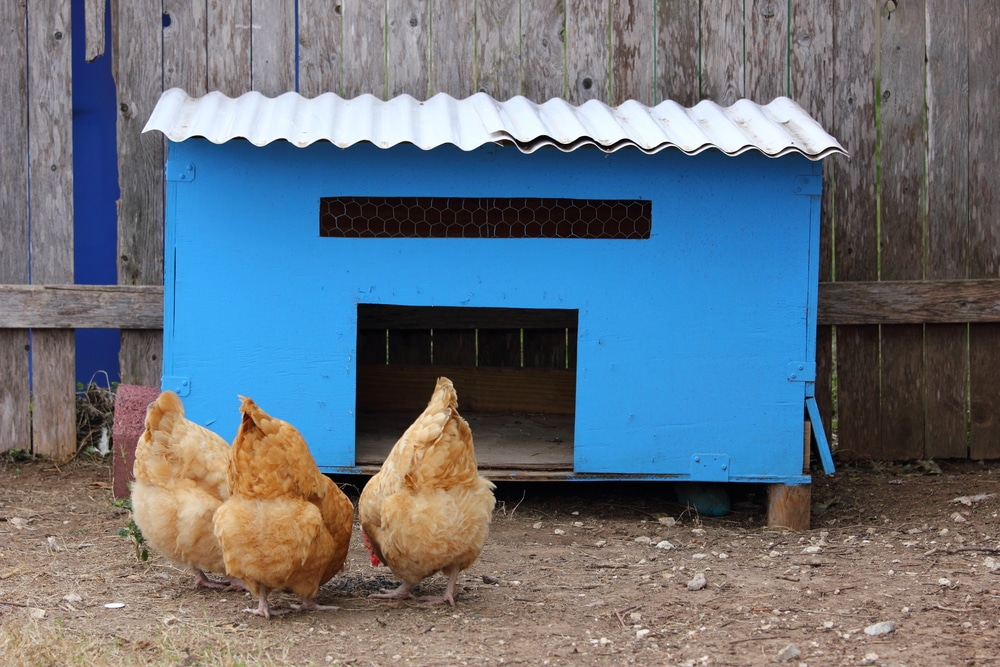
Trying to figure out the best environment in which to raise a Buff Orpington chicken? Don’t worry – these birds can thrive just about anywhere.
Since they are more or less native to the United Kingdom, they will do best in climates that experience colder winters with milder summers. Unless these chickens have access to plenty of shade, ventilation, and drinking water during the summer, they can rapidly overheat.
Some people raise Buff Orpington chickens in chicken tractors. Also known as mobile chicken pens, chicken tractors are perfect for Buff Orpingtons because they allow them to get adequate amounts of exercise without causing them to overeat. They will have access to fresh pasture all day, every day, lending to a leaner and healthier meat if you choose to butcher.
However, if you are raising Buff Orpingtons during times of extreme temperatures – like serious cold or heat – you might want to avoid a chicken tractor, as it doesn’t offer quite as much protection from the elements.
How to Raise a Buff Orpington Chicken
Raising a Buff Orpington chicken isn’t that different from raising a chicken of another breed. You need to make sure you provide your chicken with plenty of adequate shelter, particularly with a place to get out of the sun and to get away from the rain.
If your Buff Orpington chickens get wet, there is a good chance that they aren’t going to dry off easily. Their dense feathers make it difficult for them to do so. Therefore, you should include plenty of dry areas in your coop for your Buff Orpington to warm back up.
Also make sure you are keeping an eye out for common health issues in all chickens, like impacted crops, spraddle leg, and bumblefoot. Although Buff Orpingtons aren’t more prone to these issues than other types of chickens, it’s important to be vigilant so you can prevent issues from arising.
Buff Orpington Productivity
This section looks at the egg production and meat production on the Buff Orpington breed:
Are Buff Orpingtons Good for Eggs?
They sure are. In fact, Buff Orpingtons can lay more than 200 eggs each year – often surpassing 250 in just one calendar year! They aren’t known to go off laying for any reason, instead laying regularly throughout the year.
The eggs are medium to extra-large in size, depending on the hen’s individual characteristics as well as the time of year. Since they can lay eggs all year round, even during the winter months, they are highly productive members of a backyard flock. A pale brown in color, these eggs are usually some of the largest you will find.
Hens easily become broody, making them phenomenal mothers to developing chicks. However, it’s important to note that broody Buff Orpingtons can present some challenges in a flock. Broody Buff Orpington hens are proud and watchful, diligently caring for their eggs. Sa a result, gathering eggs from beneath a brooding Buff Orpington can be a challenge.
In addition, broody Buff Orpingtons have been known to become territorial and to hide their eggs in difficult-to-find and tough-to-reach locations. This can be a serious challenge for people who are trying to be profitable with their backyard egg production.
Are Buff Orpingtons Good for Meat?
The Buff Orpington is one of the most popular chicken breeds for meat. Also known as a heavy breed, it has good weight and requires very little effort from coop to table. They produce a fair amount of meat but are also hardy enough to handle most conditions.
Buff Orpingtons can be raised for meat at just 22 weeks of age. Therefore, you will usually spend less on housing and feed, since you won’t have to raise these chickens quite as long as you will other breeds.
Just watch out for obesity! While Buff Orpingtons grow out quickly, maturing faster than many other meat breeds, they like to eat. Providing unrestricted access to feed is generally a good idea, but with the Orpington chicken, you need to be careful. These birds will park themselves at the feeder and munch on grain all day!
Instead, consider moving your feeder to the opposite end of the coop from where the water supply is located. This will encourage some exercise – even if it’s only a little bit, it will improve the health of your chickens and provide a leaner, less fatty final product.
Pros and Cons of Raising Buff Orptington Chickens
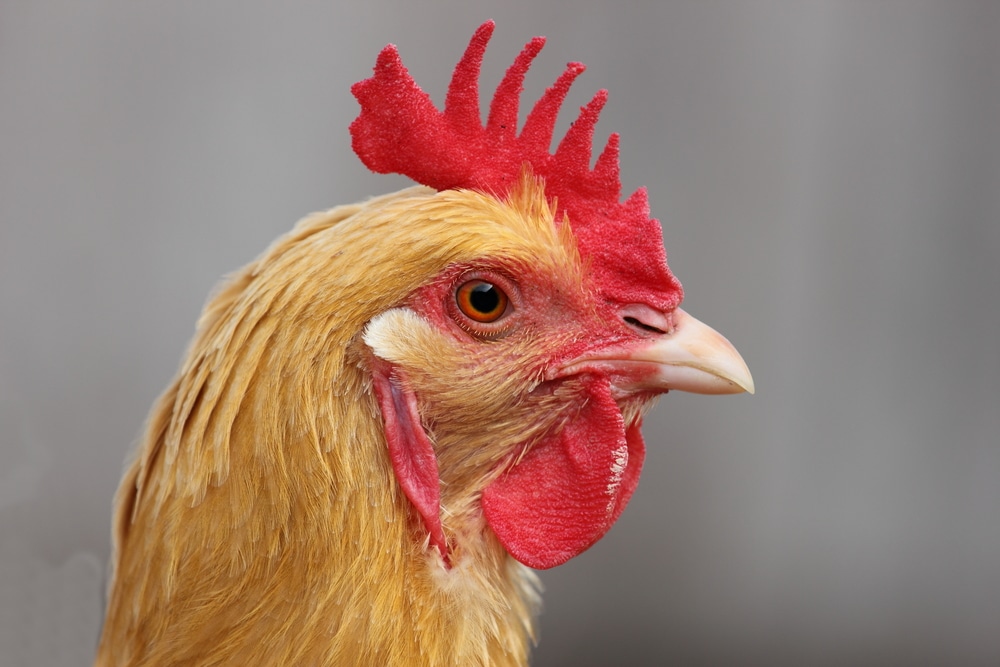
Here are a few benefits and drawback of raising Buff Oprington chickens:
Benefits of Raising a Buff Orpington Chicken
One of the most obvious benefits of raising a Buff Orpington chicken is that these chickens are reliable as meat producers as well as egg layers. They lay up to 280 eggs each year, and are ready for the dinner table as meat birds at around 22 weeks.
The Buff Orpington is also perfect for the town or city folk. Since this chicken is so quiet, it does well in confinement in a smaller yard. It’s a great chicken breed for beginners as it is so easy to handle, and it’s also exceptionally low maintenance.
If you have children or pets, then this is a breed to consider for sure. The Buff Orpington likes to be pet and picked up, and it also does well as an exhibition chicken. It doesn’t take a lot of upkeep in order to keep this chicken looking great for the show ring!
The Buff Orpington does well during the winter. Since they have such dense, fluffy feathers, they are able to shake off the cold with ease. This makes the Buff Orpington the perfect choice for more northern climates.
Another benefit of the Buff Orpington is that it is not terribly flighty. These birds are so heavy that flight is a challenge. As a result, you won’t need to erect super tall fences or even clip their wings. They should stay put in most cases.
These chickens are not noisy, nor are they bossy. They will get along well with other breeds in your flock, making them a good choice for flocks that contain multiple species of birds.
A final benefit of raising the Buff Orpington chicken breed is that they are popular heritage breeds. Heritage breeds are prized by many because they represent a piece of our culture that has long gone by the wayside – they are relics from times before.
Raising a heritage breed chicken not only allows you to raise a chicken that is well-adapted to being raised outdoors, but it also allows you to preserve a little bit of history, too.
Challenges of Raising a Buff Orpington Chicken
There are very few disadvantages of raising a Buff Orpington chicken. However, we would be remiss if we didn’t list a few!
For starters, Buff Orpington chickens are quite large – as you likely already know, since this is one of the main reasons for raising one of these birds! However, since they are so large, they have a tendency to be a bit on the lazy side. Therefore, it’s important that you encourage as much exercise for these chickens as possible.
If you plunk your chickens in a coop with a feeder and don’t provide any space or time for activity, your Buff Orpingtons will be perfectly content to sit themselves down in front of the feed trough and eat all day.
Therefore, you need to keep a close eye on these birds to make sure they don’t become obese. Yes, obese chickens are real! Providing regular activity, whether through free-ranging, contained foraging, or even toys, is essential.
Another potential challenge of raising this chicken is in its feathers. Because Buff Orpingtons have such dense feathering, it’s important that you check them on a regular basis for creepy crawlies like mites, lice, and other parasites it can be tough to see when these chickens have an infestation, so catching it early on is essential.
There are some poultry owners who even proactively dust their chickens with poultry dust. This is done as a prophylactic measure since it is so difficult to spot parasites among the dense feathering of the birds.
Another potential issue raised by the feathering of these chickens is the fact that they are not super heat-tolerant. Buff Orpingtons are basically wearing heavy down coats all summer long. Therefore, providing extra space, shade, and ventilation is essential.
In some cases, Buff Orpingtons are simply too big for some chicken keepers. There are many chicken breeders who prefer smaller breeds of chickens, like Silkies, because they don’t have very much room in their homes. If your flock is already packed with chickens of other breeds – or if your coop is small – the Buff Orpington might not be the right choice for you.
Finally, Buff Orpingtons are so docile that they tend to be situated at the very bottom of the pecking order. You will want to keep a close eye on the dynamics of your flock, as these chickens can easily be bullied by other more aggressive breeds like Welsummers or Rhode Island Reds. it is not uncommon for Buff Orpingtons to be picked on even by smaller chicken breeds!
Should You Raise the Buff Orpington Chicken?
If you are interested in a docile, productive chicken breed that will lend itself well to free-ranging as well as confinement, the Buff Orpington chicken breed is right for you. A quiet bid, this chicken is an excellent choice for beginners. In fact, this is likely one of the biggest reasons as to why these birds have seen a resurgence in popularity over the last few years!
The quintessential dual purpose chicken breed, the Buff Orpington is just one of several Orpington breeds. However, it’s one of our favorites. Until this chicken came along, the typical dual purpose chicken was scrawny and not that great at laying eggs – being mediocre at best at both of those tasks.
The Buff Orpington has truly stood the test of time. Consider raising one in your backyard flock to see for yourself!
